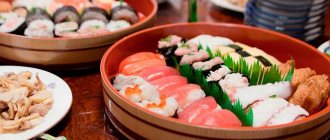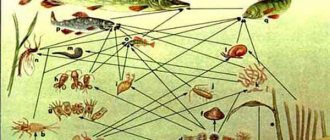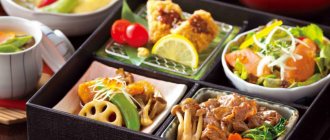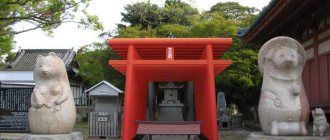I was very worried about what to eat in Japan. The fact is that I am by no means a fan of sushi, and the thought of eating raw fish is not particularly pleasant to me. Eating only rice for two weeks is also somehow sad. I was mainly hoping for noodles, because I heard that they were sold everywhere, and not only regular noodles, but also rice and buckwheat.
In fact, it turned out that Tokyo has plenty of food, and a wide variety of it. You can eat at every step - in a cafe or just in a supermarket.
Contrary to expectations, sushi is not served everywhere in Japan. This dish can only be found in specialized restaurants, which are not found at every turn. Much more often you can find ramen, soba (buckwheat noodles) or udon (wheat noodles) with various toppings (sauce, pieces of vegetables and pork, shrimp). Many cafes offer tempura, most often made from shrimp fried in batter. There are yakitori restaurants that serve only dishes from different parts of the chicken (down to the cartilage on the skewer). Sometimes the menu contains dumplings made from very thin dough, which the Japanese do not boil, but fry.
The Japanese eat rice instead of bread. Bread is also present, but rice is more popular. It serves as a kind of connector between various ingredients, and already at the first lunch I realized that this makes sense. And after a couple of days I felt that I simply needed rice so that my stomach could cope with this unusual food.
Restaurants almost always bring you a free drink: cold or hot tea, or just water, so you don’t have to worry about what to wash it down with.
You can buy sake in the supermarket, but it's disgusting to drink. Either the quality is not right, or this drink should be consumed exclusively heated, as served in a restaurant.
sake
I thought that there was almost no meat in the country, and what meat there was was terribly expensive. But in fact, a couple of pieces of pork are included in many varieties of ramen (a spicy miso (fermented beans or rice) noodle soup), and in a regular supermarket you can buy pork skewers or meatballs. In general, meat is present, although not in the form of thick chops. Small pieces of pork are most often eaten baked or stewed until they almost melt in the mouth.
The photographs and replicas of raw meat in display cases are somewhat shocking. But they eat this meat cooked, not raw. It’s just more beautiful when raw, so customers are given the opportunity to evaluate the quality of the meat and make a choice, and only then these slices are fried.
Food replicas in a display case
Raw meat on an advertising stand in front of the entrance to a cafe
Exterior of a cafe in Tokyo serving meat
Sometimes meat and chicken kebabs are fried right on the street and sold right away
Soups and sticks
The Japanese love soups very much, but they eat them all the time. If we are used to eating soup for lunch, then in Japan it’s the other way around. Most often in the land of the rising sun, liquid first courses are eaten for breakfast and dinner.
The most popular soups in Japan are:
- Miso is a soup made from fermented soybeans with seaweed, fish, onions, vegetables and seasonings. It is often an ingredient in other Japanese soups.
- Ramen (Ramen) is a first dish based on wheat ramen noodles. Other ingredients you can use are chicken, seafood, vegetables, etc. There are a lot of recipes, but one thing is common - the finished products are poured with broth, and not boiled in it .
- Shiitake is a soup based on the mushroom of the same name (shiitake, shiitake, lentinula edible, Japanese forest mushroom). It may contain tofu cheese, other types of mushrooms, vermicelli, a little sake or rice wine.
- Tanuki – the basis for this dish is an assortment of different cheeses. Chicken, herbs, and sometimes vegetable or butter are also added to it.
- Kimchi – This dish is not like regular soup or Korean kimchi. It is made from pickled vegetables, pork or chicken, soy sauce with the addition of herbs and spices.
Many people are interested in the question of what the Japanese eat soup with . There are two ways to eat such dishes - with chopsticks and a ceramic spoon. Moreover, a specific method is used for each type of soup.
If Japanese soup needs to be eaten with chopsticks, this is how the Japanese do it. They can drink the broth first and then eat the leftovers. Or vice versa - first, use chopsticks to fish out all the ingredients, and then drink the liquid. And sometimes they use chopsticks and a spoon alternately.
Miso soup
Anyone who would like to understand in detail the benefits and harms of meat, as well as get an idea of healing nutrition that ensures health and longevity, can do this by reading the book by Shatalova G.S. Healing nutrition
https://www.rulit.me/books/celebnoe-pitanie-read-510246-1.html
Shatalova G.S. she herself was a model of health and longevity, pulling hopeless patients, whom official medicine had abandoned, from the abyss and returning them to 100% health.
Galina Sergeevna Shatalova conducted many experiments proving that with healthy nutrition a person can reduce food consumption by 5-7 times compared to accepted standards and still feel good.
In 1983, a group of athletes who switched to healthy nutrition, i.e. on plant foods, participated in the annual 7-day ultra-marathon dedicated to Cosmonautics Day along the route Gagarin - Kaluga - Moscow - Zvezdny with a length of about 500 km. When preparing for the race, they received no more than 800 kcal, and on days of particularly heavy loads up to 1200 kcal. with plant foods. All other athletes ate according to the standards developed by the Institute of Nutrition and received 6000 kcal from high-calorie foods, also recommended by the Institute of Nutrition. Energy consumption during the run was estimated at 5000-6000 kcal per day. Four athletes were selected as a control group, who, in terms of physical capabilities and level of training, approximately corresponded to Shatalova’s group. The result was stunning: the athletes from Shatalova’s group turned out to be more resilient and, unlike the others, they not only did not lose weight, but even gained weight.
Shatalova also conducted several experiments with climbers.
A continuation of the experiment with climbers was an expedition of mountain tourists in the Ala-Archa climbing camp, in which two men and two women participated. One of them was the author of these lines. We got up before sunrise and went to the mountains without breakfast. We walked about 15 km (according to the pedometer we took with us) and returned to camp by five o’clock in the evening. Here the doctor and the camp director weighed and examined us, after which we went to lunch.
Our diet included hot stews, freshly prepared porridges from sprouted wheat, and decoctions of wild herbs with juniper and barberry. After lunch, talking calmly, we walked another 10 km, but now not up, but down the slopes of the mountains, after which we returned. Thus, we covered about 25 km per day. We slept in the open air, ate once a day, and drank twice. None of us lost weight or got sick with anything. On the contrary, they left healthier and full of strength.
And finally, to complete the conversation about experiments with climbers and mountain tourists, let me remind you of our trek along mountain trails from Nalchik to Pitsunda; lasting 23 days. At this time, our daily diet consisted of 50 g of buckwheat and 100 g of dried fruit during heavy physical activity. Suffice it to say that during the days of travel we overcame four mountain passes. We entered Pitsunda vigorous and cheerful, while our random fellow travelers-tourists, who ate in accordance with the recommendations of the theory of balanced nutrition, could barely move their legs from fatigue.
Even more impressive were the results of the four walking treks I organized through the Central Asian deserts. Both I and my companions received no more than 600 kcal per day from food, while walking up to 30-35 km per day along shifting sands in a sharply continental desert climate.
Particularly instructive was the first one I have already mentioned, which took place in July-August 1987, during which, at the request of the Geographical Society of the USSR, I also checked the possibilities of reducing the generally accepted norm of water consumption during summer hikes in the desert. Previously, it was believed that during the hot summer months, during hiking expeditions into the hot sands, a person needed to consume at least 10 liters of water to ensure sufficient thermoregulation of the body.
It was believed that sweat, by moisturizing the surface of the skin and then evaporating, cools it. But I am a doctor and I know that when water enters the body, it is not just “directly” released through the pores, but goes through a series of serious transformations that require considerable energy expenditure from the body. Therefore, excess fluid intake weakens and overheats it. By the way, this phenomenon has been known since ancient times. It is no coincidence that Julius Caesar, before selecting replacements for his legions from among the candidates, arranged a secret test. The recruits had to make a long trek on foot without receiving a drop of water, after which they were given the opportunity to drink to their heart's content. Those who drank a lot and greedily, which is called “avidly”, were rejected.
15 people were preparing for the experiment, but for various reasons only 11 were able to take part in it. The group included researchers who needed to study exposed areas of the Aral Sea bottom in conditions of complete waterlessness, since there was not a single well along the way, as well as tourists . All of them were trained in the Natural Health System and completely switched to healing nutrition. The full group had to travel along the Aralsk-Karateren route, 125 km long. It was supposed to cover this distance in seven days, but five was enough for us. At that time I was already over 70, but I was not a burden. On the contrary, she set an example for others of endurance and patience. From Karateren, I returned with tourists to Moscow, and the researchers moved on. Subsequently, one of them received the honor of being included in the Guinness Book of Records for his participation in this expedition.
During the experiment, I was able to reduce water consumption in desert conditions by 10 times.
First, the fact that transition participants consumed exclusively low-protein, low-calorie foods, completely devoid of animal products, which require 42 grams of water per gram of protein, played a role.
Secondly, we drank structured water enriched with herbs, which does not increase, but decreases body temperature.
The reflex reaction of the oral mucosa in the desert was also taken into account. She immediately responds to the consumption of ordinary cold water with insane thirst. It turned out that it was enough to put an ordinary pebble or raisin in your mouth for saliva to begin to be secreted, a natural structured liquid, and the thirst subsided. Hot water with the addition of herbs has the same effect.
All this, as I already said, made it possible to reduce water consumption to one liter per day without compromising health, but with a significant increase in the efficiency of the body’s thermoregulation.
When I started my experiment, the last thing I expected was that it would cause such a wide response. A lot of letters arrived, including from abroad, in which, along with words of admiration, there were also notes of doubt. And the letter that came from the former Czechoslovakia directly stated that reducing water consumption below 10 liters was simply impossible for purely physiological reasons.
To dispel the doubts of my opponents, I decided to organize a new expedition, inviting participants from Czechoslovakia. Such a joint expedition took place the following year, 1988, and included six people on each side: five of my followers, who, like me, live according to the Natural Health System, the author of these lines, and five well-trained athletes from Czechoslovakia. The sixth was the translator who accompanied them. And although my compatriots were physically less prepared, not one of them left the race. Three from the foreign group dropped out immediately. One of them could not stand the training hikes in the dry mountains of Kopet-Dag, another was exhausted on the second, the other on the third day of the trek. The rest, including the translator, walked 134 km with us, after which their strength dried up. This was to be expected, because they ate high-calorie foods containing large amounts of animal proteins, and each drank at least 10 liters of water per day. They looked extremely exhausted.
The members of our group looked great and felt so good that, having delivered their foreign colleagues to their usual places, they decided to return to the 134th kilometer and walked the route to the end, covering another 272 km.
My report to the Scientific Research Institute of Physical Education on the results of all the experiments carried out in 1983-1989 made such a great impression that I was allocated funds to carry out one more, the final, most ambitious and evidence-based one.
Thanks to the financial support of the institute, I was able to attract to participate in it seven former patients cured by me in the Natural Health System, suffering from such common chronic diseases as insulin-dependent diabetes, chronic, drug-resistant hypertension, peptic ulcer of the duodenal bulb, severe pyelonephritis against the background of drug therapy. allergies, liver cirrhosis, heart failure in obesity. The group also included a patient whom I cured of Vater’s nipple cancer. Before the start of the experiment, they all underwent the most thorough examination at the Research Institute of Physical Culture and received permission to participate in a 500-kilometer walk through the sands of the Central Karakum along the route Bakhar-den-Kurtamysh Reserve.
After careful preparation, which took us 10 days, we set out. We moved off-road, getting stuck in sand that was hot up to 50°C. Nevertheless, we walked easily, enjoying the unique majestic beauty of nature, grandiose, breathtaking sunrises and sunsets. They slept on a small felt, huddled closely together. At one of the overnight stops, the desert presented me with a memorable souvenir: in the ring of the backpack lying under my head there remained the dry skin of a snake that had crawled through it, which thus got rid of the old skin.
We ate once a day, drinking green tea with honey and raisins added to it, which have the property of cooling the skin. Water consumption, as usual, did not exceed one liter per day.
Initially, it was planned to complete the route in 20 days, but the participants in the trek were able to endure heavy physical activity so easily that we completed it in 16 days.
At the finish line, everyone felt great, not only maintaining their body weight, but also increasing it. And this is with a minimum amount of food and water.
What conclusions can be drawn from a truly unique series of experiments that I prepared and carried out over just over seven years (1983-1990)? Moreover, here I have not talked about all of them, but only about the most significant of them, in some sense milestones, in many of which I took a personal part. And this, by the way, is an important circumstance, once again indicating the high effectiveness of the Natural Health System, in which I have lived for more than 40 years. Because, you see, not every young healthy man can walk 500 km along the scorching sands of the desert, and after all, I was 74 years old at that time.
But if we ignore emotions and try to translate the results of experiments into the dispassionate language of numbers, then it is not difficult to notice that the System of Natural Health, and when I talk about it, I certainly mean its integral part—healing nutrition—transfers a person from a state of “practical » health (or practical ill health, which is essentially the same thing) into a state of complete actual health. The first state is characteristic of artificial man, born of modern sick civilization, the second - for reasonable man, who has heeded the voice of nature and obeyed its instructions.
Of course, it is incredibly difficult for an individual to try to deviate even one step from generally accepted ideas about a “rational”, “balanced” diet. That is why I pay so much attention to the promotion not of local systems and methods that allow one to cure certain diseases, but of knowledge about the laws and principles of life of living organisms, and above all humans. Only such knowledge, which has become an inner conviction, can strengthen your determination to resist deformed public opinion, help you turn those around you from your involuntary antipodes into allies and like-minded people, and seek and find your way to the temple of Nature, which gives us that feeling of supreme harmony, which we call spirituality .
https://radosvet.in/16684-samyy-masshtabnyy-eksperiment-500-kilometrovyy-perehod.html
Salt, sugar and glutamate
In Japan, it is not customary to salt food . If this is done, it is only for the purpose of salting. The fact is that the vast majority of products are of marine origin; they already have a salty taste. But the Japanese love sugar . They can add it to salad, meat and of course different sauces.
It’s worth mentioning separately about the third seasoning – monosodium glutamate. In Japanese, there is a separate word for its taste: “ Umami ”. Monosodium glutamate is widely used throughout Asia and is added to all dishes and sauces.
Many CIS residents have the impression that monosodium glutamate is harmful. All this is due to the lack of education and blind faith of the media, which are ready to invent anything and pass it off as a sensation. Monosodium glutamate is an absolutely harmless product (if you don’t eat it with spoons, of course











